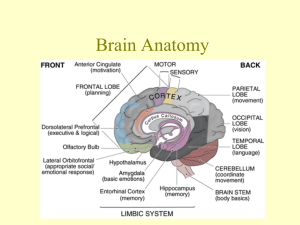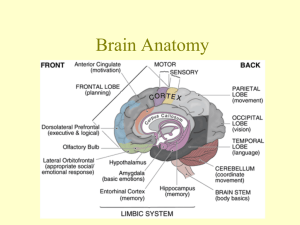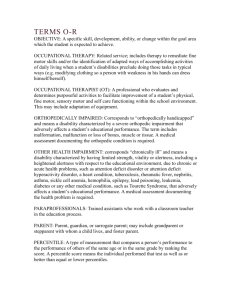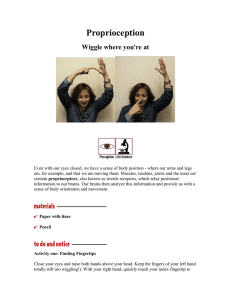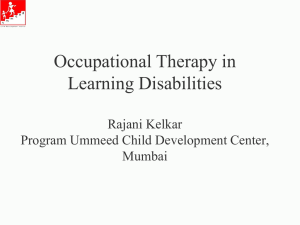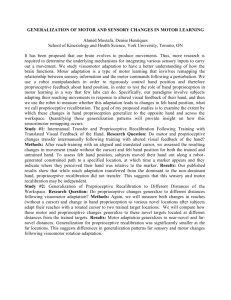Commonly Used Terms by Occupational Therapists
advertisement
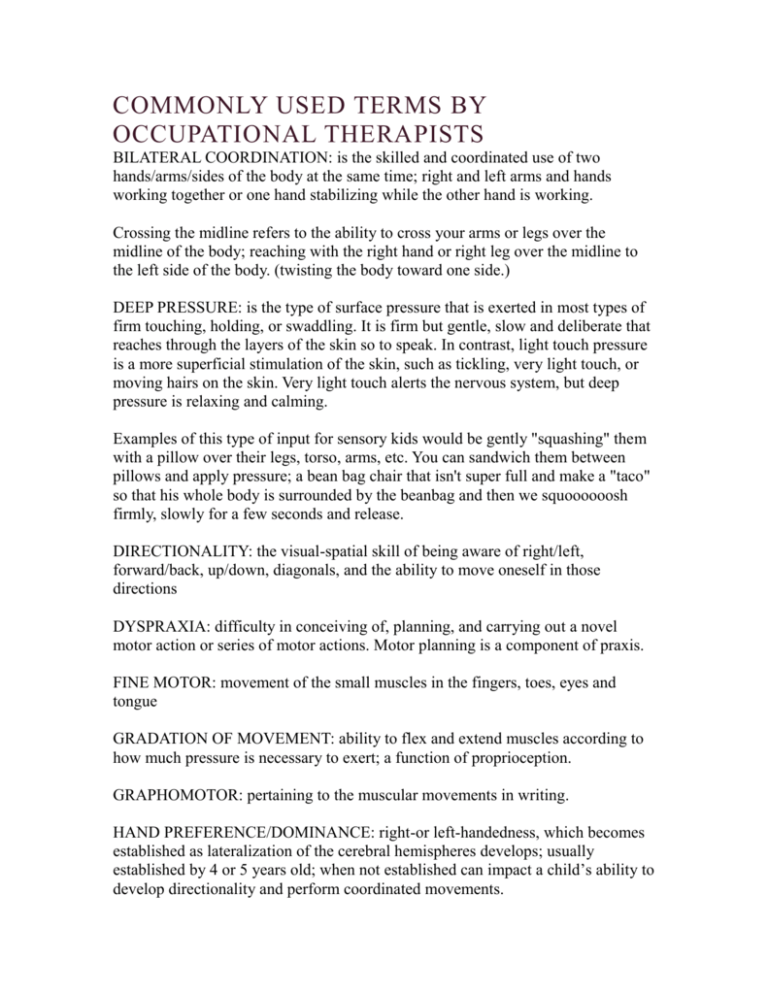
COMMONLY USED TERMS BY OCCUPATIONAL THERAPISTS BILATERAL COORDINATION: is the skilled and coordinated use of two hands/arms/sides of the body at the same time; right and left arms and hands working together or one hand stabilizing while the other hand is working. Crossing the midline refers to the ability to cross your arms or legs over the midline of the body; reaching with the right hand or right leg over the midline to the left side of the body. (twisting the body toward one side.) DEEP PRESSURE: is the type of surface pressure that is exerted in most types of firm touching, holding, or swaddling. It is firm but gentle, slow and deliberate that reaches through the layers of the skin so to speak. In contrast, light touch pressure is a more superficial stimulation of the skin, such as tickling, very light touch, or moving hairs on the skin. Very light touch alerts the nervous system, but deep pressure is relaxing and calming. Examples of this type of input for sensory kids would be gently "squashing" them with a pillow over their legs, torso, arms, etc. You can sandwich them between pillows and apply pressure; a bean bag chair that isn't super full and make a "taco" so that his whole body is surrounded by the beanbag and then we squoooooosh firmly, slowly for a few seconds and release. DIRECTIONALITY: the visual-spatial skill of being aware of right/left, forward/back, up/down, diagonals, and the ability to move oneself in those directions DYSPRAXIA: difficulty in conceiving of, planning, and carrying out a novel motor action or series of motor actions. Motor planning is a component of praxis. FINE MOTOR: movement of the small muscles in the fingers, toes, eyes and tongue GRADATION OF MOVEMENT: ability to flex and extend muscles according to how much pressure is necessary to exert; a function of proprioception. GRAPHOMOTOR: pertaining to the muscular movements in writing. HAND PREFERENCE/DOMINANCE: right-or left-handedness, which becomes established as lateralization of the cerebral hemispheres develops; usually established by 4 or 5 years old; when not established can impact a child’s ability to develop directionality and perform coordinated movements. HYPER-RESPONSIVENESS/HYPERSENSITIVITY/SENSORY DEFENSIVENESS: observable behavior involving a quick or intense response to sensory stimuli that others usually perceive as benign; an exaggerated response or withdrawal from stimuli HYPO-RESPONSIVENESS/HYPOSENSITIVITY: behavior involving a slow response to sensory stimuli; requiring high intensity or increased duration of the stimuli to invoke an observed behavioral response; tendency to be sensory-seeking and/or difficult to engage IN-HAND MANIPULATION: involves manipulating an object within one hand. The fingers and thumb are used to best position the object for the activity. For example, picking up a pen and moving it into position with your fingers for writing, or moving a coin from your palm to fingertips to put into a slot of a piggybank. In-hand manipulation is one of the most complex fine motor skills. Children who have difficulty with in-hand manipulation may be slow or unable to complete some everyday activities. KINESTHETIC AWARENESS: awareness of joint position and body movement in space, such as knowing where to place one’s feet when climbing stairs, where to place one’s fingers on a pencil, etc. without visual cues. OCULOMOTOR SKILLS: movements of muscles in the eyes, including binocularity, fixation, focusing and tracking Binocularity or binocular coordination: how well the eyes work together as a team (skill and endurance) Convergence/divergence: the basic oculomotor skill of accommodating one’s vision smoothly between near and distant objects (such as the blackboard and desk when copying) PERSEVERATE: to continue an activity or behavior when no longer appropriate PROPRIOCEPTION: is considered the sixth sense; developed by the nervous system as a means to keep track of and control the different parts of the body. Rather than sensing external reality, proprioception is the sense of the orientation of one's limbs in space. It is the sense that indicates whether the body is moving with required effort, as well as where the various parts of the body are located in relation to each other. Proprioception is what police officers test when they pull someone over and suspect drunkenness. Without proprioception, we'd need to consciously watch our feet to make sure that we stay upright while walking. SELF-REGULATION: the ability to control one’s activity level and state of arousal; self-organization SENSORIMOTOR: pertaining to the brain-behavior process of taking in sensory messages and reacting with a physical response TRIPOD GRASP: the grasp of a writing tool using three fingers (thumb, index, middle) VESTIBULAR SENSE: the balance and movement sense that responds to changes in head position, body movement and the pull of gravity; coordinates movments of the eyes, head and body; affects balance, muscle tone, visual-spatial perception, auditory language and emotional security. Receptors are in the inner ear. VISUAL ACUITY: The degree to which the eye can distinguish fine detail at varying distances, also termed the clarity of vision. VISUAL MEMORY: Memory that holds visual information. VISUAL MOTOR INTEGRATION: refers to the ability to coordinate the motor movement with visual stimulus, it involves both a perceptual input and motor output. Fine motor integration is the ability to skillfully move the hand under guidance of the eyes. VISUAL PERCEPTION: ability to perceive and interpret what the eyes see; may include position in space, figure-ground, visual-closure, form-constancy VISUAL-SPATIAL DEFICIT: A reading disorder marked by difficulty linking letters together to form whole words.




